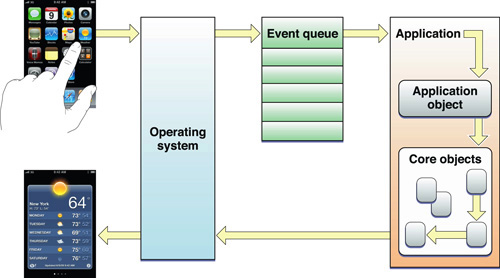Main event loop
https://developer.apple.com/library/archive/documentation/General/Conceptual/Devpedia-CocoaApp/MainEventLoop.html
In the main event loop, an application continuously routes incoming events to objects for handling and, as a result of that handling, updates its appearance and state. An event loop is simply a run loop: an event-processing loop for scheduling work and coordinating the receipt of events from various input sources attached to the run loop. Every thread has access to a run loop. In all but the main thread, the run loop must be configured and run manually by your code. In Cocoa applications, the run loop for the main thread—the main event loop—is run automatically by the application object. What distinguishes the main event loop is that its primary input source receives events from the operating system that are generated by user actions—for example, tapping a view or entering text using a keyboard.

The Application Object Gets and Dispatches Events
Just after an application is launched, it sets up the infrastructure for the main event loop. It establishes a connection with those underlying system components that are responsible for the delivery of low-level user events. The application receives these events through an input source installed in the main thread’s run loop. Because the application must handle each event separately, in order of its arrival, these low-level events are placed in a first-in first-out event queue.
Once the initial user interface is on the screen, the application is thereafter driven by external events. The application object obtains the topmost object in the event queue, converts it to an event object (UIEvent on iOS, NSEvent on OS X), and dispatches it to other objects in the application for handling. When the call that dispatched the event returns, the application fetches the next object in the queue and dispatches it. It continues doing this until the application terminates.
Core Objects Respond to Events and Draw the User Interface
When an application is launched, it also sets up a core group of objects that are responsible for drawing the user interface and handling events. These core objects include windows and various kinds of views. When the application object gets an event from the event queue, it dispatches it to the window in which the user event occurred. The window sends the event to the view that is the most appropriate handler for it:
For multitouch and mouse events, the view is the one under the touch or mouse pointer.
For keyboard, motion, and other events, the view is the first responder.
If this initial view does not handle the event, it can pass it to other views in the application via the responder chain.
In handling the event, the view often initiates a series of actions that modify the appearance of the application and update the application’s state and data. When these actions have been completed, control returns to the application, which fetches the next event from the event queue.
Prerequisite Articles
Related Articles
Definitive Discussion
Event Handling Guide for iOS
Sample Code Projects
(None)
Main event loop的更多相关文章
- PYTHON ASYNCIO: FUTURE, TASK AND THE EVENT LOOP
from :http://masnun.com/2015/11/20/python-asyncio-future-task-and-the-event-loop.html Event Loop On ...
- [Javascript] Task queue & Event loop.
Javascript with Chorme v8 engine works like this : For Chorme engine, v8, it has call stack. And all ...
- 以setTimeout来聊聊Event Loop
平时的工作中,也许你会经常用到setTimeout这个方法,可是你真的了解setTimeout吗?本文想通过总结setTimeout的用法,顺便来探索javascript里面的事件执行机制. setT ...
- 浏览器与Node的事件循环(Event Loop)有何区别?
前言 本文我们将会介绍 JS 实现异步的原理,并且了解了在浏览器和 Node 中 Event Loop 其实是不相同的. 一.线程与进程 1. 概念 我们经常说 JS 是单线程执行的,指的是一个进程里 ...
- 【原】以setTimeout来聊聊Event Loop
平时的工作中,也许你会经常用到setTimeout这个方法,可是你真的了解setTimeout吗?本文想通过总结setTimeout的用法,顺便来探索javascript里面的事件执行机制. setT ...
- IDEA 运行报错 failed to create a child event loop
背景 在IDEA中写了测试代码,但是运行的时候一直提示 java.lang.IllegalStateException: failed to create a child event loop ... ...
- 事件轮询 event loop
Understanding the node.js event loop The first basic thesis of node.js is that I/O is expensive: So ...
- The Node.js Event Loop, Timers, and process.nextTick() Node.js事件循环,定时器和process.nextTick()
个人翻译 原文:https://nodejs.org/en/docs/guides/event-loop-timers-and-nexttick/ The Node.js Event Loop, Ti ...
- js的事件循环(Event Loop)
(本文从掘金小册整理) 首先介绍一下几个概念 进程与线程 相信大家经常会听到 JS 是单线程执行的,但是你是否疑惑过什么是线程? 讲到线程,那么肯定也得说一下进程.本质上来说,两个名词都是 CPU 工 ...
随机推荐
- python初学者-鸡兔同笼简单算法
鸡兔同笼问题.假设共有鸡.兔30只,脚90只.求鸡.兔各有多少只 使用for循环快速解决鸡兔同笼问题 for ji in range(0,31): if 2*ji+(30-ji)*4==90: pri ...
- windows使用git bash 无法交互键盘上下键移动选择选项的解决方法
目录 遇到的问题 解决方案 1. 直接通过数字键来选择 2. 使用 winpty 来启动命令 3. 将 git bash 换成 cmd 4. 使用vscode中是bash 遇到的问题 windows使 ...
- Atlas 2.1.0 实践(2)—— 安装Atlas
在完成Atlas编译以后,就可以进行Atlas的安装了.Atlas的安装主要是安装Atlas的Server端,也就Atlas的管理页面,并确保Atlas与Kafka Hbase Solr等组件的集成. ...
- Pytest测试框架(五):pytest + allure生成测试报告
Allure 是一款轻量级.支持多语言的开源自动化测试报告生成框架,由Java语言开发,可以集成到 Jenkins. pytest 测试框架支持Allure 报告生成. pytest也可以生成juni ...
- 转载-notepad++ zend-coding使用
转载-notepad++ zend-coding使用 zen-Coding是一款快速编写HTML,CSS(或其他格式化语言)代码的编辑器插件,这个插件可以用缩写方式完成大量重复的编码工作,是web ...
- 不吹不黑,jupyter lab 3.0客观使用体验
1 简介 jupyter lab于近期发布了其具有里程碑意义的3.0版本,随之带来的一些重要新特性,想必广大读者朋友已在各大公众号所翻译转载的jupyter lab团队官方介绍文章中知晓了很多. 图1 ...
- CS系统中分页控件的制作
需求:在一个已有的CS项目(ERP中),给所有的列表加上分页功能. 分页的几个概念: 总记录数 totalCount (只有知道了总记录数,才知道有多少页) 每页记录数 pageSize (根据总 ...
- node.js常用内置模块一
在使用内模块的时候需要先将所需的内置模块进行引入. OS模块 在nodejs中OS模块提供了与操作系统相关的属性和方法 // 导入OS内置模块,必须先进行导入,否则无法使用 const os = re ...
- python Logger模块单例模式
前言 提前祝大家过个好年 最近忙于项目,今天抽出点时间写写Blog谈谈昨天遇到的问题 项目最近要收尾了,想把Logger规整一下,因为很多地方都有用到 Python的Logger模块是Python自带 ...
- LeetCode225 用队列实现栈
使用队列实现栈的下列操作: push(x) -- 元素 x 入栈 pop() -- 移除栈顶元素 top() -- 获取栈顶元素 empty() -- 返回栈是否为空 注意: 你只能使用队列的基本操作 ...
